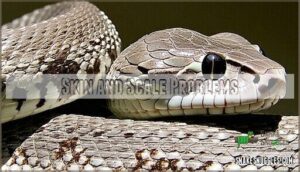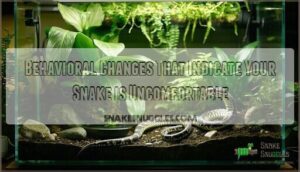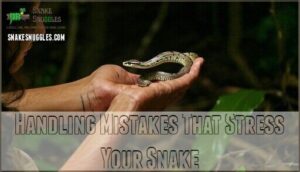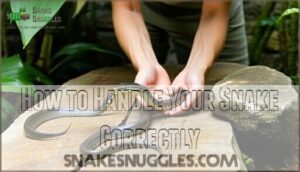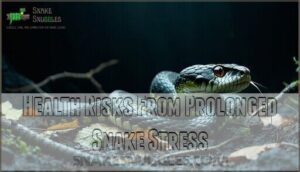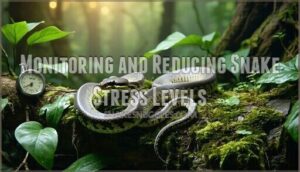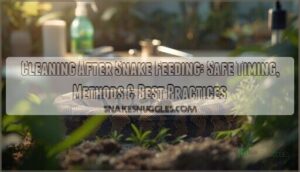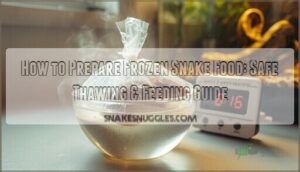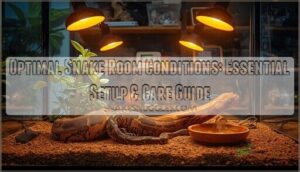This site is supported by our readers. We may earn a commission, at no cost to you, if you purchase through links.
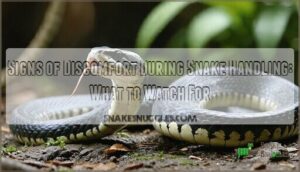
A snake breathing heavily with its mouth slightly open isn’t just tired—it’s showing respiratory distress or extreme stress. Muscle tension rippling through the body, abnormal positioning, and rapid tongue flicking all tell a story that many keepers ignore until it’s too late.
Learning to read these signals protects both you and your snake from unnecessary stress and potential injury. The difference between a relaxed management session and a stressful encounter often comes down to recognizing what your snake is telling you in those first few seconds.
Table Of Contents
- Key Takeaways
- What Are The Physical Signs of Snake Discomfort?
- How Does Snake Body Language Signal Stress?
- Behavioral Changes That Indicate Your Snake is Uncomfortable
- Environmental Factors That Cause Snake Discomfort
- Handling Mistakes That Stress Your Snake
- How to Handle Your Snake Correctly
- Creating a Stress-Free Environment for Your Snake
- Health Risks From Prolonged Snake Stress
- Monitoring and Reducing Snake Stress Levels
- When to Seek Veterinary Care for Your Snake
- Frequently Asked Questions (FAQs)
- Conclusion
Key Takeaways
- Your snake’s body language reveals distress through heavy breathing, muscle tension, abnormal positioning, and rapid tongue flicking—signals that appear seconds before defensive strikes and often get missed until stress escalates into health problems.
- Physical warning signs like hissing, S-shaped coiling, tail rattling, tight balling up, and striking behavior tell you to stop handling immediately, as ignoring these defensive signals leads to unnecessary stress for both you and your snake.
- Environmental mistakes cause more stress than handling alone—incorrect temperature gradients, poor humidity levels, inadequate hiding spots, and cramped enclosures create chronic anxiety that weakens your snake’s immune system and shortens its lifespan.
- Prolonged stress triggers serious health consequences including respiratory infections, scale rot, feeding refusal, and immune system collapse, making early recognition of discomfort signs essential for preventing expensive vet visits and potentially fatal conditions.
What Are The Physical Signs of Snake Discomfort?
Your snake’s body tells you a lot about how it feels. Physical signs of discomfort often show up before behavior changes become obvious.
Here are the main physical indicators you should watch for during interaction.
Heavy or Rapid Breathing Patterns
When your snake’s breathing shifts from smooth and silent to heavy or rushed, something’s clearly wrong. Healthy snakes breathe quietly and slowly.
Watch for mouth breathing, wheezing sounds, or rapid breathing patterns—these are textbook signs of snake stress and potential respiratory distress. These infection signs can escalate to aspiration pneumonia if ignored.
Snake behavior signs like this demand immediate attention since addressing snake stress improperly worsens the condition.
Abnormal Body Positioning and Muscle Tension
Beyond labored breathing, your snake’s posture and muscle tension reveal just as much about its comfort level. Watch for stargazing posture—when the head points unnaturally upward—or head tilting and torticollis, which signal neurological distress.
Muscle rigidity, tremors, and nervous behaviors during stressed snake restraint indicate serious discomfort.
Abnormal body positioning like excessive weaving or spinal deformities requires immediate veterinary attention to prevent long-term damage.
Skin and Scale Problems
Your snake’s skin tells a story. Skin discoloration—brownish, red, yellow, or green-black scales—often signals Scale Rot, a potentially fatal infection linked to poor substrate hygiene and persistent moisture. Look for raised scales from blood pooling underneath or skin lesions on the belly.
Shedding Issues like stuck skin point to low humidity. Fungal Infections from Ophidiomyces cause crusty patches and scarification from substrate contact, especially on ventral scales where Environmental Factors hit hardest.
Early detection of these issues is key since untreated scale rot can be fatal.
Changes in Eye Appearance
Your snake’s eyes can reveal stress just as clearly as its scales do. Cloudy eyes during shedding are normal, but persistent cloudiness suggests infection or dehydration. Sunken eyes signal severe dehydration requiring immediate attention.
Watch for unusual dilated pupils or constricted pupils in stable lighting—both indicate stress indicators tied to restraint problems.
Eye discharge points to respiratory infections or environmental issues affecting your snake’s behavior.
How Does Snake Body Language Signal Stress?
Snakes can’t tell you when they’re uncomfortable, but their body language speaks volumes. When a snake feels threatened or stressed during interaction, it uses specific physical signals to communicate its distress.
Here are the main defensive behaviors you’ll want to recognize before they escalate.
Defensive Posturing and Hissing
Think of hissing like a smoke alarm—it’s your snake’s way of saying "back off" before things escalate. Defensive posturing involves specific body language that tells you interaction should stop immediately.
Your snake might display these defensive signals:
- S-shaped neck coiling that puts the head in strike preparation position
- Flattening of the body to appear larger and more intimidating
- Loud hissing sounds created by forcing air through the glottis
- Pulling back or recoiling when you reach toward them
These defensive behaviors mean your snake feels threatened and needs space right now. Regular interaction can help to keep a snake tame, so consider frequent interaction sessions.
Striking or Lunging Behavior
When a defensive display doesn’t work, some snakes shift into offense mode—striking or lunging forward with lightning speed. This defensive reflex happens in milliseconds—some species reach strike speeds of 8 feet per second. You’ll see the head shoot forward in a blur, sometimes with mouth wide open. Even nonvenomous snakes use this defensive behavior to protect themselves.
Bite prevention starts with recognizing aggression early. Proper care and training methods reduce these incidents dramatically.
Tail Rattling and Vibration
Many snakes rattle or vibrate their tails against surfaces when they feel cornered—a warning behavior that works across both venomous and harmless species. The rattling frequency and vibration intensity increase as stress levels climb.
You’ll notice species variation in this mimicry behavior—nonvenomous snakes like rat snakes copy rattlesnakes to ward off threats. These defensive signals mean your snake needs immediate space during interaction.
Coiling Tightly or Balling Up
Some snakes exhibit a unique defensive mechanism when they’ve hit their stress limit: they curl into tight balls or compress their bodies like a spring under pressure. Ball pythons are particularly famous for this behavior, tucking their heads inside to form a protective sphere.
This body language is a clear sign of extreme anxiety and serves as a warning to stop handling them immediately. The muscle tension you feel when lifting a coiled snake further emphasizes just how uncomfortable it has become with the interaction.
Behavioral Changes That Indicate Your Snake is Uncomfortable
Snakes don’t always make their discomfort obvious through body language alone. Sometimes the clearest warning signs show up in how they behave day to day.
Here are four behavioral changes that tell you your snake isn’t comfortable.
Refusal to Eat or Drink
A loss of appetite often acts like a red flag—something’s off. Anorexia triggers in captive snakes include environmental shifts, health issues, or restraint stress. Up to 20% of snakes refuse food during stressful periods, and voluntary fasting can stretch from weeks to months. Behavioral indicators matter: if your snake won’t strike at food or backs away repeatedly, it’s signaling discomfort. Prolonged consequences include weight loss, weakened immunity, and organ damage.
Common causes of feeding refusal:
- Pre-shed phase – About 65% of snakes stop eating before shedding begins.
- Temperature or humidity problems – Husbandry factors account for 22% of appetite loss cases.
- Recent restraint or enclosure changes – Stress-linked avoidance behavior spikes after disturbances.
- Illness – Mouth infections, pneumonia, or obstructions cause 15–30% of refusals.
- Reproductive cycles – Gravid females often fast until after giving birth.
Watch snake behavior closely. If your snake refuses meals for two weeks straight or won’t drink water, especially after restraint, take it seriously. Extended anorexia beyond four weeks leads to significant body mass decline and health risks.
Excessive Hiding or Avoiding Interaction
If your snake suddenly acts like it wants nothing to do with you—retreating to its hide every chance it gets—you’re watching a clear stress signal unfold. Healthy snakes explore their enclosure during active hours, but stressed ones show constant hiding behavior and interaction avoidance.
Enclosure changes trigger this defensive response, especially during acclimation periods. Interaction impact compounds the problem—repeated disturbances teach escape behavior. Snake stress signs like this warn you to back off and let your snake settle.
Increased Activity or Restlessness
While some snakes shut down and hide when stressed, others react the opposite way—you’ll notice them constantly moving, glass surfing, or acting restless even during their normal rest periods. This pacing behavior signals agitation.
Watch for:
- Constant enclosure exploration along tank walls
- Repeated escape attempts at lid corners
- Nervous weaving motions and restless sleep patterns
Escape behavior intensifies with poor tank conditions. Interacting with a snake showing these agitation signs only worsens things—your snake’s telling you something’s wrong with its environment.
Regurgitation After Feeding
A healthy snake that suddenly throws up an otherwise normal meal is waving a bright red flag about stress or treatment mistakes. Regurgitation often happens when you pick up your snake too soon after feeding—digestion time matters. Temperature effects and food size play important roles too.
Watch for these signs of stress: interaction impact within 48 hours of meals, improper temperature gradients, or oversized prey. Stress factors compound quickly and weaken your snake.
Environmental Factors That Cause Snake Discomfort
Your snake’s enclosure isn’t just a home—it’s the foundation of its health and comfort. When the environment falls short, stress builds quickly and shows up in ways you mightn’t expect.
Let’s look at the key factors that can throw your snake off balance.
Incorrect Temperature Gradients
Why does temperature matter so much? Incorrect thermal gradients disrupt your snake’s digestive efficiency and immune response. When temperatures drop below 75°F or exceed 92°F, you’ll notice lethargy and food refusal.
These environmental stressors trigger brumation risks and weaken disease resistance. Extreme temperature swings increase mortality rates by causing respiratory infections and metabolic failure.
Monitor your tank conditions closely to prevent snake stress from poor environmental conditions.
Poor Humidity Levels
Just as temperature controls your snake’s metabolism, humidity determines whether its respiratory system stays healthy or slides into distress. Poor humidity monitoring causes shedding problems and respiratory issues that weaken your snake’s defenses. Low hydration levels create interaction stress because species needs vary dramatically.
Watch for these signs of stress from environmental factors:
- Retained eye caps or incomplete sheds indicate humidity below species requirements
- Wheezing or mucus around nostrils signals respiratory infection from dry air
- Excessive soaking behavior means your snake is compensating for low moisture
- Dull, wrinkled skin shows dehydration from inadequate ambient humidity
- Difficulty breathing or gaping mouth reveals serious respiratory distress requiring immediate intervention
Inadequate Enclosure Size and Setup
Your snake can’t stretch out properly when its tank feels like a studio apartment designed for a hamster—and that cramped feeling translates directly into chronic stress. Tank dimensions matter because incorrect tank conditions force your snake into constant contact with walls, disrupting its natural movement patterns and space utilization needs.
| Enclosure Issue | Stress Signal |
|---|---|
| Undersized tank | Constant glass rubbing |
| Poor substrate quality | Respiratory infections |
| Inadequate enrichment needs | Repetitive pacing |
| Minimal vertical space | Reduced exploration |
Small spaces create hiding scarcity and prevent proper thermoregulation.
Lack of Hiding Spots and Enrichment
Without a proper hideout or two tucked into different temperature zones, your snake becomes a sitting duck—constantly exposed, perpetually anxious, and unable to perform basic stress-relief behaviors like secure resting.
Enrichment importance can’t be overstated since environmental enrichment directly bolsters natural behaviors and mental stimulation.
Essential hiding variety and environmental factors:
- Multiple hides in different temperature zones prevent thermal stress
- Size matters—your snake should fit snugly without getting wedged
- Diverse textures and shapes encourage exploration and natural behaviors
- Climbing branches and varied substrate add mental stimulation
- Regular rotation of enrichment prevents boredom and maintains engagement
Handling Mistakes That Stress Your Snake
Even experienced snake owners make interaction mistakes that cause unnecessary stress. Some errors seem minor but can trigger serious discomfort or health problems in your snake.
Here are the most common interaction mistakes you need to avoid.
Handling Too Soon After Feeding
Feeding time triggers a delicate digestive process, and if you interrupt it by grabbing your snake too soon, you’re asking for trouble—often in the form of regurgitation.
Wait at least 48 hours after feeding before interacting with snakes. This timing lets digestion complete and prevents stress that weakens your snake’s immune system.
Interacting too early disrupts food processing and creates unnecessary risk.
Excessive or Rough Handling
Grabbing your snake like you’re picking up a garden hose or squeezing too hard is a fast track to stress, injury, and defensive behavior. Improper care techniques cause muscle strain and breathing problems.
Keep sessions under 15 minutes and use gentle care techniques that provide full body support. Frequency matters—limit interactions to avoid chronic snake stress. Your snake needs time between sessions to feel secure.
Handling During Shedding or Illness
When your snake’s skin turns milky or its body fights infection, touching it feels like prodding a sunburn—uncomfortable and potentially harmful. During shedding, your snake’s vision blurs and its skin becomes sensitive, making snake stress worse.
Illness vulnerability means even gentle interaction drains energy needed for recovery support. Skip interactions entirely until shedding completes and health returns.
Minimizing stress during these critical periods prevents respiratory issues and allows proper healing.
Not Supporting The Snake’s Body Properly
Imagine balancing a garden hose full of water using just your fingertips—that’s how vulnerable your snake feels when its body lacks proper support during holding. Without a secure grip along its length, muscle strain and spinal injury become real risks.
Dropping danger increases when you don’t support the body evenly, and regurgitation risk spikes if pressure concentrates near the stomach.
Proper snake body support means distributing weight across multiple contact points, reducing snake stress and preventing snake behavior signs of discomfort during holding.
How to Handle Your Snake Correctly
Proper care keeps your snake calm and prevents unnecessary stress. The key is knowing when to pick up your snake, how to support its body, and when to back off.
These four practices will help you build trust while keeping both you and your snake safe.
Timing Your Handling Sessions
The hours right after a meal are critical because your snake needs quiet time to digest without any stress or movement that could trigger regurgitation.
Follow these interaction practices to minimize snake stress:
- Wait 48-72 hours after feeding before any snake interaction
- Avoid interaction during shedding sensitivity when vision is impaired
- Never interact during illness interaction situations or visible health issues
- Adjust interaction frequency based on species differences and individual temperament
Each snake reacts differently to interaction, so watch your snake’s cues carefully.
Using Proper Hand Placement and Support
Once you’ve got your timing right, how you actually pick up your snake makes all the difference between a calm experience and a defensive strike.
Support the body with both hands so the snake’s weight spreads evenly instead of dangling from one spot. Use a secure grip without squeezing or pinching. Let your snake weave between your fingers with gentle contact while maintaining proper body support throughout.
Recognizing When Your Snake Doesn’t Want Interaction
Even with perfect hand placement, your snake will sometimes tell you loud and clear that it’s just not in the mood for being held. Recognizing these subtle cues prevents stressed snake interactions and builds trust over time.
Watch for these defensive behaviors:
- Hissing or striking motions – Your snake is warning you to back off before things escalate
- Rapid escape attempts – Constant weaving away or attempting to flee shows fatigue from being held
- Tense body posture – Tight muscles and rigid movements signal discomfort
Individual temperament varies by species, so learn your snake’s unique signals.
Gradual Acclimation for New Snakes
New snakes need time to decompress before you start reaching into their world, so patience during those first few weeks pays off big time. Wait at least five to seven days after arrival before attempting any snake interaction.
This initial observation period lets your snake adjust to its new environment without added pressure. Start with brief interaction sessions of just two to three minutes, gradually increasing as your snake shows signs of acclimation and reduced stress.
Creating a Stress-Free Environment for Your Snake
Your snake’s enclosure is the foundation of its wellbeing. Getting the environmental parameters right means your snake can thrive instead of just survive. Here’s what you need to dial in to keep stress levels low.
Setting Up Proper Temperature and Humidity
Your snake’s tank needs to hit specific temperature and humidity targets—miss them, and you’re creating stress before you even touch your pet. Different species need different conditions, so research your snake’s requirements first.
- Temperature gradients: Create a warm side (85-90°F) and cool side (75-80°F) so your snake can regulate its body temperature
- Humidity sources: Use water bowls, substrate misting, or humid hides to maintain proper moisture levels
- Monitoring equipment: Install reliable thermometers and hygrometers to track environmental factors accurately
- Seasonal adjustments: Modify heating and humidity slightly during winter months to prevent environmental stress factors
Choosing Appropriate Substrate and Decorations
Substrate and decorations aren’t just about aesthetics—they directly affect your snake’s comfort, safety, and stress levels. Choose substrate that accommodates burrowing needs and offers cleaning ease—aspen shavings work well for dry-climate species while coconut husk suits tropical snakes.
Add branches, rocks, and plants for environmental enrichment and hiding spots. Avoid rough decorations that could injure scales during movement.
Your enclosure setup should balance substrate safety with enrichment value, reducing environmental factors that trigger stress.
Providing Adequate Hiding Places
Hidden snakes are healthy snakes—without at least two secure hiding spots, your pet will spend most of its time in a state of anxiety. Place hides on both the warm and cool ends of your enclosure so your snake can thermoregulate without feeling exposed.
The hiding spot size should fit snugly—too large and your snake won’t feel secure. Use opaque materials with secure hide design to block visual stimuli that trigger snake stress during snake interactions.
Maintaining Proper Lighting and Ventilation
Most snake keepers focus on temperature and humidity, but improper lighting and poor ventilation can quietly sabotage your snake’s health just as quickly. Natural light cycles help regulate behavior—aim for 12 hours on, 12 hours off unless your species needs different basking bulbs or lighting spectrum.
Ventilation methods matter too: stagnant air traps ammonia and prevents humidity control, turning environmental stress factors into respiratory nightmares. Cross-flow ventilation keeps air fresh without creating drafts.
Health Risks From Prolonged Snake Stress
Stress isn’t just uncomfortable for your snake—it’s dangerous. When stress becomes chronic, it triggers a cascade of health problems that can seriously harm or even kill your pet.
Here’s what prolonged stress does to your snake’s body.
Weakened Immune System and Infections
Prolonged snake stress acts like a slow poison, quietly compromising your pet’s defenses against disease. When chronic stress takes hold, immune suppression leaves snakes vulnerable to opportunistic infections that healthy animals would normally fight off. This creates a dangerous cycle where stress weakens immunity, infections cause more stress, and veterinary intervention becomes increasingly urgent.
Watch for these warning signs of a weakened immune system:
- Respiratory infections with wheezing or mucus discharge
- Skin lesions that don’t heal or worsen over time
- Mouth rot with swollen gums or discoloration
- Recurring parasitic infections despite treatment
Preventative care through proper husbandry stops most problems before they start. However, stressed snakes may develop antibiotic resistance if infections aren’t caught early, making veterinary care more complicated and expensive later.
Respiratory Problems and Pneumonia
When breathing becomes labored, your snake isn’t just uncomfortable—it’s fighting a battle that could quickly turn life-threatening. Respiratory infections and pneumonia develop when snake stress compromises defenses, often worsened by humidity impact from poor enclosure conditions. Aspiration risk increases during feeding-related stress.
Watch for wheezing, mucus bubbles, and open-mouth breathing—signs demanding immediate veterinary care.
Prevention tips include proper temperature gradients and humidity levels to support respiratory distress recovery.
Scale Rot and Skin Lesions
Beneath those scales lies skin that can quickly deteriorate when stress and poor conditions create the perfect storm for bacterial infections. Scale rot appears as discolored patches, blisters, or ulcers—particularly on the belly where moisture accumulates. Causes of scale rot include excess humidity and dirty substrate.
Identifying lesions early matters because treatment options like topical antibiotics work best before infection spreads. Veterinary care ensures proper diagnosis, while preventing infections means keeping enclosures clean and dry.
Shortened Lifespan and Chronic Health Issues
Stress left unchecked doesn’t just make your snake miserable today—it chips away at years they should have lived. Chronic infections flourish when the stress-immune link weakens defenses. Over time, organ damage accumulates from the longterm effects of stress.
While genetic predisposition plays a role, lifespan reduction accelerates dramatically when snake health and wellbeing suffer under persistent pressure. Longterm stress consequences mean fewer years with your companion.
Monitoring and Reducing Snake Stress Levels
Keeping your snake healthy means staying on top of stress signals and making smart changes when needed. The best approach combines careful observation with steady improvements to your setup.
Here’s how to monitor your snake’s wellbeing and create a calmer environment.
Documenting Behavior and Environmental Changes
Keeping a detailed log of your snake’s daily habits and tank readings can reveal stress patterns before they turn into serious health problems. Write down feeding responses, shedding cycles, and any behavioral changes you notice during interaction sessions. Track temperature and humidity readings alongside these observations.
This creates behavioral baselines that make it easier to spot when something’s off. Your environmental logs also help your vet understand what might be triggering snake stress signs if you need professional advice.
Making Gradual Adjustments to Tank Conditions
After you’ve tracked those changes for a while, start tweaking your setup in small steps rather than overhauling everything at once. Gradual changes give your snake time to adjust without triggering new stress responses. Monitor effects carefully during each adjustment phase before moving to the next one.
Acclimation timeline for environmental changes:
- Adjust one parameter at a time – Change temperature, humidity, or substrate individually so you can identify what works
- Wait 3-7 days between modifications – This acclimation timeline lets your snake settle and reveals environmental causes of stress
- Add environmental enrichment gradually – Introduce new hides or climbing branches one piece at a time for a comfortable environment
Minimizing Disturbances and Noise
Snakes don’t just react to what’s inside their tank—they’re wired to notice everything happening around it. Loud noises, vibrations from footsteps, and sudden movements all register as threats. Position your snake’s enclosure away from high-traffic areas and establish quiet hours during their active periods to minimize stress indicators.
Sensitive species need extra consideration. Gradual introduction to household sounds helps, but soundproofing enclosure areas and vibration reduction mats under tanks make a real difference for anxious snakes during interaction sessions.
| Common Disturbance | Impact on Snake Behavior |
|---|---|
| Heavy foot traffic | Triggers defensive posturing and hiding |
| Loud music or TV | Causes elevated stress and restlessness |
| Frequent room entry | Interrupts natural snake behavior patterns |
Regular Health Monitoring and Checkups
Routine checkups catch problems before they spiral into emergencies—schedule veterinary visits at least once a year, even when your snake seems perfectly healthy.
Between vet appointments, track your snake’s weight monthly and watch for hydration assessment signs like sunken eyes. Parasite screening and proper quarantine protocols for new arrivals protect your entire collection.
Regular snake health monitoring means you’ll spot subtle changes that signal trouble early.
When to Seek Veterinary Care for Your Snake
Some health issues can’t wait. While minor stress is manageable at home, certain symptoms signal serious problems that need immediate attention. Here’s when your snake needs a veterinarian right away.
Persistent Refusal to Eat
If your snake suddenly loses interest in food, it’s not always an emergency. But when the loss of appetite stretches beyond two to four weeks—especially outside of shedding or breeding season—it’s time to call a vet. Here’s what makes persistent anorexia serious:
- Weight Loss Threshold: Dropping more than 10% of baseline body weight signals trouble and requires veterinary intervention.
- Species Vulnerability: Ball pythons are particularly prone to prolonged food refusal, with over 15% experiencing anorexia at some point.
- Hidden Culprits: Over 60% of extended anorexia cases stem from underlying infections, metabolic disorders, or husbandry errors you mightn’t notice.
Pair snake stress signs like lethargy or abnormal shedding with feeding patterns that suddenly shift, and you’re looking at a clear signal for professional help. Managing snake stress means recognizing when snake behavior changes cross the line from quirky to concerning.
Breathing Difficulties or Open-Mouth Breathing
Your snake gasping with its mouth open isn’t just uncomfortable—it’s a red flag for respiratory disease. Open-mouth breathing, audible wheezing, clicking sounds, or bubbles from the nostrils signal potential snake pneumonia that demands immediate veterinary care. Respiratory issues affect up to 5.6% of pet snakes, and about 70% of abnormal breathing patterns stem from infections or environmental problems.
| Symptom | What It Looks Like | Urgency Level |
|---|---|---|
| Open mouth breathing | Snake holds mouth open while at rest | Immediate care needed |
| Audible sounds | Wheezing, clicking, or rattling during breathing | Urgent—same day |
| Nasal discharge | Bubbles or mucus from nostrils | High priority |
| Labored breathing | Visible effort with each breath, rapid breathing patterns | Emergency visit |
| Reduced activity | Over 80% decrease in normal movement | Seek care promptly |
When you spot these snake stress signs, don’t wait. Heavy breathing combined with lethargy indicates airway obstructions or pneumonia that worsen quickly. Addressing snake stress means recognizing that respiratory distress requires professional intervention—delay compromises your snake’s prognosis considerably.
Visible Injuries or Skin Problems
Your snake’s skin tells a story—wounds, persistent sores, or abnormal discoloration demand immediate attention. Skin shedding issues affect 28.2% of pet snakes, while injuries like rostral cuts appear in 7.4%.
Watch for these critical skin problems:
- Crusting and scale damage with color changes (seen in 97.9% of skin lesion cases)
- Dysecdysis (incomplete shedding) persisting beyond 1–2 cycles
- Ulceration or swelling indicating possible fungal infections
- Mite infestations causing abnormal shedding patterns
Address skin lesions and shedding problems promptly—they signal husbandry errors or underlying disease requiring wound care and professional assessment.
Dramatic Behavioral Changes
Sudden shifts in your snake’s behavior—lethargy dropping active time by over 50%, unexpected aggression, or repeated regurgitation—signal trouble. Over 45% of stressed or ill snakes show atypical aggression, social withdrawal, or hypersensitivity to touch. Excessive activity and escape attempts (reported in 51.1% and 45.9% of cases) often indicate pain from illness.
Rapid breathing, hissing, defensive behaviors, and tail rattling are stress signals demanding immediate attention. If behavioral shifts are severe or persist beyond normal adjustment periods, veterinary evaluation prevents further decline.
Frequently Asked Questions (FAQs)
How often should I handle my snake weekly?
Most snakes thrive with interaction frequency of once or twice weekly. Gentle interaction techniques help with snake socialization while stress reduction strategies prevent overwhelming your pet. Interaction limits vary by species and temperament.
Can snakes recognize their owners scent or voice?
You’d think snakes would know who feeds them, but scent recognition trumps everything else. Snakes can’t process vocal cues like mammals do, yet they detect owner familiarity through chemical signals during interaction sessions.
What time of day is best for handling?
Interact with your snake during its active period for better responses. Most species are crepuscular or nocturnal, so evening interaction schedules work best. Daytime interaction suits diurnal species.
Consistent daily routines reduce stress and help you apply gentle interaction techniques while monitoring environmental factors.
Do different snake species have different stress triggers?
Picture a ball python versus a green tree python—both serpents, totally different worlds. Yes, species stress variations matter greatly. Snake behavior studies reveal environmental adaptations shape what triggers stress.
Arboreal species panic without vertical space, while burrowing snakes need deep substrate, making species research essential for proper care techniques.
How long does it take stressed snakes to recover?
Recovery from stress varies by severity and cause. Most snakes show improvement within days to weeks after you correct environmental issues and reduce contact.
Stress recovery time depends on proper snake rehabilitation through environmental adjustments and minimizing disturbances during recovery.
Conclusion
Ignoring the signs of discomfort during snake management sets you up for problems you won’t see coming until they’re already serious. Your snake’s stress today becomes tomorrow’s respiratory infection or feeding refusal.
The signals are there every time you interact—heavy breathing, defensive coiling, muscle tension rippling through the body. Most keepers learn to read these cues only after a bite or a vet visit forces the lesson.
You can skip that painful education by watching closely and responding immediately when your snake tells you something’s wrong.
- https://pmc.ncbi.nlm.nih.gov/articles/PMC10908839/
- https://www.nature.com/articles/s41598-018-30709-x
- https://www.wildlifedemonstrations.com/post/scale-rot-how-to-identify-and-treat
- https://redinational.com/how-often-does-a-snake-shed-its-skin/
- https://www.barkandwhiskers.com/2015-07-09-nl-snake-anorexia/



